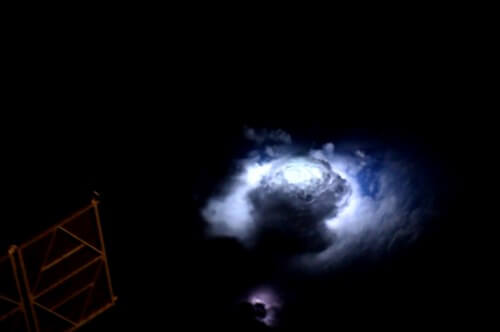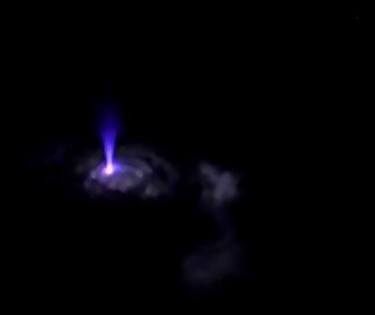Prof. Yoav Yair from the Interdisciplinary Center in Herzliya who was responsible for the weather forecasts in the experiment, which is a continuation of the experiment conducted by the late Ilan Ramon on the Columbia shuttle: "We were able to predict the strong storm over India where the elves were photographed"

The Danish astronaut Andreas Mogensen dedicated three shifts in recent days to the THOR project, which monitors atmospheric phenomena that rise into the upper atmosphere from lightning storms, which was initiated by Prof. Yoav Yair, head of the School of Sustainability at the Interdisciplinary Center in Herzliya. This is as a continuation of the Madex experiment on the space shuttle Columbia carried out by the late Ilan Ramon and a similar experiment carried out by a Japanese astronaut several years ago from the space station.
In a statement from the Danish Space Agency operating at the Technological Institute of Denmark (DTU Space) it was stated that Mogensen was able to photograph "red elves" and blue jets as well as lightning in thunderstorms from the International Space Station.
Mogensen photographed a storm over India from the Cupola Module - a glass bell that is located below the space station and is used for observations of the Earth. Mogensen's photographs are part of the THOR project led by the Technical University of Denmark (DTU) in collaboration with the Danish Meteorological Service.
"Both institutions are very satisfied with the images," says Torsten Neubert, Chief Advisor of the Technical University of Denmark: "We expected to see good images of thunderstorms from space and asked to examine the procedures and workflow of the THOR experiment. However, due to the brevity of the task, we did not expect to reach scientific achievements. We were wrong, he managed to photograph blue jets - which are lightning coming out of clouds at an altitude of 50 kilometers. But not only that, for the first time we also saw pulses of blue rays - flashes of light one after the other, like we see normal lightning storms at low altitude."
The person who served as a remote sensing consultant for the project, Prof. Yoav Yair, head of the School of Sustainability at the Interdisciplinary Center in Herzliya, is the one who provided the weather forecasts: "It's amazing to see these violent thunderstorms at night. We managed to predict the storms correctly, and Andreas photographed them.”
Project Thor is part of a larger project of the European Space Agency for monitoring the interrelationships between the atmosphere and space Atmosphere-Space Interactions Monitor (ASIM), in which the Danish Space Agency is responsible for the scientific management and part of the development of the instruments, and Therma Company led the technical consortium. ASIM will be the largest Danish project to be installed on the International Space Station in 2017. ASIM consists of two cameras and three photometers that will measure the different wavelengths of visible light as well as a large X-ray detector. While ASIM will observe thunderstorms with instruments looking directly down at the ground during the Thor experiment, the astronauts will photograph the horizon. The goal is to develop THOR expert astronauts who will follow in Mogensen's footsteps and perform measurements with THOR systems.

In an interview with the Copenhagen-based Hadaan site, Prof. Yair says that Mogensen had three shifts on Tuesday-Thursday this week. On the first day he took about 150 pictures of lightning storms in Mexico and Panama, and the next day he took pictures of lightning along a path that went from Thailand, Vietnam to Japan, where Hurricane Kilo raged this week, and where we expected to capture leprechauns.
"The experiment is working perfectly according to the plan. I work here with scientists from the Technical University of Copenhagen DTU SPACE, which is the National Space Institute, and from the Meteorological Service of Denmark. Every morning we prepared the list of targets, which we sent to the operational control center in Brussels, where the experts analyzed what could be photographed in the next day and what could not, according to the station's route. The data is then transferred to the control center of the European Space Agency near Munich."
"The guy took control of the matter and was able to manipulate the camera so easily that he announced that he also wanted to use his free time to photograph elves during the passage over the night side of the earth, but of course these were random observations that were not part of the experiment."
The chief scientist of the university was happy for my help. I feel that the professionalism I developed in the two previous flights both in the Medex experiment on the Columbia shuttle and with the Japanese astronaut in the COSMIC SHORE project helped me a lot to improve the procedure of identifying the targets because this time they had much less time. Therefore, I had to refine the predictions and reach the best goals, but after all, you also need a little luck."
"In general," concludes Prof. Yair, who returned to Israel yesterday, "Mogensen is an extraordinary person, a nice guy and very talented, a doctor of engineering from the University of Houston. I had a very great experience working here. I am happy that I brought honor to the Interdisciplinary Center and the State of Israel, the name of Israel appears on the assignment and of course I will receive all the data and be a participant in the research of these photographs."
More of the topic in Hayadan:
- Nine astronauts at the same time on the International Space Station
- Prof. Yoav Yair will accompany an experiment by a Danish astronaut who will reproduce the lightning experiment conducted by Ilan Ramon
- Prof. Yoav Yair: "Because of global warming, the frequency of haze and dust storms like the one happening now will increase"
